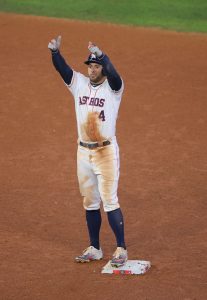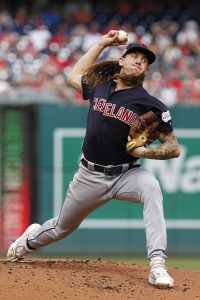While most of this year’s top-tier free agents could stuff new-team swag in their family’s stockings, veteran third baseman Josh Donaldson remains unsigned a third of the way through January. That’s nothing compared to the laborious matchmaking processes we witnessed last year. And it’s hardly uncommon historically. But it does leave us with at least one protracted offseason drama to witness.
It has seemed at times as if momentum could be building toward a signing. But the latest run of reporting injects new uncertainty into the body of publicly reported information regarding the bidding.
Perhaps growing impatient with the increasingly drawn-out nature of the Donaldson negotiations, and/or seeking leverage in talks, the Twins have begun to explore the trade market for alternative approaches to improving their club, Dan Hayes and Aaron Gleeman of The Athletic report (subscription required). The Twins, per the report, have “seen an uptick” in the volume of trade talks over the past three days as they explore additions at a variety of positions. The club isn’t limiting itself to corner infield options and remains open to adding a starting pitcher if the opportunity presents itself.
Meanwhile, the Washington Post’s Jesse Dougherty writes that the Nationals have “all but moved on from Donaldson.” That’s perhaps contradictory with recent reporting indicating that the Nats haven’t pulled their offer, but the two could also coexist. It’s plausible, for instance, that the Nationals could leave their previously standing offer on the table but that the team also doesn’t intend to actively pursue a signing and doesn’t expect to land Donaldson. At minimum, with Starlin Castro, Howie Kendrick, Eric Thames and Asdrubal Cabrera all in the fray, the D.C. org obviously feels no pressure to push up its bid.
At this point, it’s fair to wonder just how close the Donaldson camp will get to the third baseman’s reported asking price — said just a few days ago to sit in the vicinity of $110MM. Ever since Anthony Rendon signed, we’ve heard talk of heavy interest in Donaldson. And an expectation has emerged more recently that he would enter the rarefied nine-figure realm. Indeed, as we discussed last week, MLB.com’s Mark Feinsand reported that the Twins, Nationals and Braves “all have four-year offers out to [Donaldson] in that $100MM range.”
What exactly constitutes the “$100MM range” is perhaps subject to some degree of interpretation, but the most recent reports out of Minnesota and Atlanta don’t exactly dovetail with that line of thinking. 1500 SKOR North radio’s Darren Wolfson suggested that the Twins’ offer was more in the $80-85MM range, while MLB.com’s Mark Bowman reported on doubt as to whether the Atlanta organization was even close to the top bidder.
Notably, Dougherty writes in the aforementioned Washington Post column that the Nationals did indeed make a four-year, $100MM offer to Donaldson. But it’s important to bear in mind that, with the Nationals more than any other club, the surface-level number of an offer can be somewhat misleading. The Nationals utilize deferred money in their long-term contracts more than any club in baseball, and while there’s been no firm indication that their offer to Donaldson marked a continuation of that trend, it’d hardly be a surprise to learn that’s indeed the case. The Nats, after all, have baked deferrals into the contracts of Max Scherzer, Stephen Strasburg, Patrick Corbin, Anibal Sanchez and Matt Wieters in recent years. One of the primary reasons that Rendon was said to have spurned Washington’s final extension offer (seven years, $215MM) was because of significant deferred monies.
The question, then, is where the price pressure will come from at this point if Donaldson and his reps at MVP Sports Group are truly determined to secure a deal in the vicinity of that reported $110MM price point. That Donaldson remains unsigned well into January — Hayes notes that the Twins originally believed he preferred to sign prior to Christmas — suggests that none of the bidders have been willing to do so. And the loss of the Nationals as a driving force could leave Donaldson with two highly cost-conscious organizations patiently engaged in a staring contest.
MVP was able to find $300MM for Manny Machado last February, so we may presume some patience on that side of the table as well. But it’s tougher in this case to identify a club that could emerge as a viable nine-figure suitor for an already 34-year-old third baseman, even after an elite 2019 season. The Dodgers, Rangers, Phillies, and others could afford to but haven’t shown any appetite for a massive, lengthy pact. One or more of those clubs could in theory jolt the market a bit by dangling higher-AAV, shorter-term offers. But even in that scenario, getting into the desired realm would still require prodding the Atlanta and/or Minnesota organizations into stretching their valuations yet further. It could ultimately turn out that D.C. is the only place Donaldson can reach the century mark — even if only in nominal form, depending upon deferrals — though that could certainly still change.
It was always going to be difficult to push Donaldson into this rarefied air. As we debated our top 50 free agent list, we felt there’d be broad and strong interest in the hot corner stalwart. But we ultimately capped the prediction at three years and $75MM based upon his age and health history.
To be sure, we’ve rarely seen a player of quite this present-day ability available on the open market at this precise age. But the data points available suggest that teams have been unwilling both to extend on the length of the deal and to pay a premium annual salary. Kevin Brown was the original $100MM player. So far as we can ascertain, he’s also still the only man to receive a total promise of that magnitude entering his age-34 or later season. (The news of his signing was met with rather boldly stated consternation from some notable figures around the game.) Carlos Beltran was a monster in 2011, his age-34 season, but settled for a two-year, $26M deal in the ensuing winter. His health and performance trajectory in advance of free agency closely mirror those of Donaldson. Much more recently, Ben Zobrist secured four years, but at a relatively modest $56MM guarantee. Defensively limited slugger Edwin Encarnacion took down $60MM over three years entering his age-34 season.


